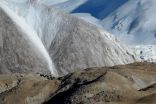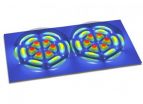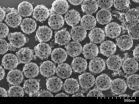(Press-News.org) NEW YORK (June 17, 2014) – A new study led by the Wildlife Conservation Society says that in wild yak societies, it's the mothers that are the real climbers. The study found that mothers with young venture on steeper terrain and slightly higher elevation than either males or females without young.
The authors of the study expect that this strategy is an adaptive way to avoid predators and to access more nutritious food. Wild yaks are an endangered species occurring only on the Tibetan Plateau and closely related to North American bison.
The study, which appears in the June issue of the Journal of Mammalogy is authored by Joel Berger of the Wildlife Conservation Society and the John J. Craighead professor at University of Montana; Ellen Cheng of the Ugyen Wangchuck Institute for Conservation and Environment; Aili Kang of WCS; Michael Krebs of the University of Montana; Lishu Li of Beijing; Zhao Xin Lu and Buqiong Buzhou of Kekexili National Nature Reserve Management Bureau; and George Schaller of WCS and Panthera.
The study reported that wild yak females are found on mountainous slopes averaging 15,994 feet and in groups of about 30 whereas males were more frequently in valley bottoms and groups of just two.
Wild yaks are the largest grazer north of the tropics; while weights are rarely known, they are larger than bison. Domestic yaks were once bred with bison in northern Canada in the 1920's in an attempt to make for more cold-hearty animals.
The authors of the study say that the remoteness of the wild yak's habitat gives conservationists an opportunity to study a species that has not been largely impacted by humans. Bison on the other hand, have been greatly impacted by human activity and habitat fragmentation. Their ability to range in higher elevations has been largely lost although skulls have been found in the Rocky Mountains above 12,000 feet in Utah, Colorado, and Wyoming.
Lead author Joel Berger of WCS and University of Montana said: "Neither habitat destruction nor fragmentation are issues in the yak's home in far western China, and so there are amazing opportunities to learn about why males and females respond differently to climate change and biological challenges. But, more fundamentally, just as people climb mountains in the Himalayas because they are there, here we have a throwback to the Pleistocene; it is still here, and we by uniting people from different countries have the opportunity to conserve a species, not to mention an ecosystem and a landscape that is larger than all of Montana and Nebraska combined."
INFORMATION:
This research was made possible through the generous support of the National Geographic Society and U.S. National Park Service.
Wildlife Conservation Society (WCS)
MISSION: WCS saves wildlife and wild places worldwide through science, conservation action, education, and inspiring people to value nature. VISION: WCS envisions a world where wildlife thrives in healthy lands and seas, valued by societies that embrace and benefit from the diversity and integrity of life on earth. To achieve our mission, WCS, based at the Bronx Zoo, harnesses the power of its Global Conservation Program in more than 60 nations and in all the world's oceans and its five wildlife parks in New York City, visited by 4 million people annually. WCS combines its expertise in the field, zoos, and aquarium to achieve its conservation mission. Visit: http://www.wcs.org; http://www.facebook.com/TheWCS; http://www.youtube.com/user/WCSMedia Follow: @thewcs.
CONTACT: STEPHEN SAUTNER: (1-718-220-3682; ssautner@wcs.org
JOHN DELANEY: (1-718-220-3275; jdelaney@wcs.org)
Study: In wild yak society, moms are the real climbers
2014-06-17
ELSE PRESS RELEASES FROM THIS DATE:
Promising T cell therapy
2014-06-17
This news release is available in German. The cells of the human immune system are created from special stem cells in the bone marrow. In diseases affecting the bone marrow, such as leukemia, the degenerate cells must be destroyed using radiation or chemotherapy. Subsequently, the hematopoietic system has to be replaced with stem cells from the blood of a healthy donor. Because of the resulting temporary weakening of the immune system, patients are more exposed to viruses that would normally be warded off.
The cytomegalovirus (CMV), which can cause serious damage to ...
Laser physics upside down
2014-06-17
This news release is available in German.
Sound waves fade, water waves ebb, light waves are dissipated by a wall. The absorption of waves is a very common phenomenon. But only recently have physicists realized that amazing new possibilities are opened up, when this energy loss, rather than being seen as an annoying nuisance, is actually considered a desired effect. At the Vienna University of Technology, a system of two coupled lasers has been created, in which wave dissipation leads to a behaviour completely contrary to intuition: additional energy can switch it ...
Research at Granada finds that the eye's optical quality deteriorates after alcohol consumption
2014-06-17
A study conducted by the University of Granada has scientifically proven that alcohol consumption markedly impairs night-vision because it increases the perception of halos—luminous circles—and other visual night-time disturbances. Moreover, this deterioration of vision is significantly greater in subjects with breath alcohol content in excess of 0.25mg/litre—the legal limit for driving in Spain and other countries and, also, that recommended by the World Health Organization (WHO).
Researchers from the Laboratory of Vision Sciences and Applications conclude that alcohol ...
Does the moon affect our sleep?
2014-06-17
Popular beliefs about the influence of the moon on humans widely exist. Many people report sleeplessness around the time of full moon. In contrast to earlier studies, scientists from the Max Planck Institute of Psychiatry in Munich did not observe any correlation between human sleep and the lunar phases. The researchers analyzed preexisting data of a large cohort of volunteers and their sleep nights. Further identification of mostly unpublished null findings suggests that the conflicting results of previous studies might be due to a publication bias.
For centuries, people ...
How does a tree know it's time to grow again?
2014-06-17
Winter takes its toll on living things. To protect themselves from the elements, bears hibernate, and trees go dormant. Biologists have observed what happens when trees become dormant, but up to now, they haven't understood the underlying genetic mechanisms that enable them to start growing again.
Led by molecular geneticists from Michigan Technological University a gene has been identified and characterized that tells a poplar tree when winter ends and a spring growing season begins. Victor Busov, a professor in Michigan Tech's School of Forest Resources and Environmental ...
Long-term study suggests ways to help children learn language and develop cognitive skills
2014-06-17
Examining factors such as how much children gesture at an early age may make it possible to identify and intervene with very young children at risk for delays in speech and cognitive development, according to a new study by researchers at the University of Chicago.
The research by leading early learning scientists looked at children from a wide variety of backgrounds, including those from advantaged and disadvantaged families, and those who had suffered brain injury. Their work was published in an article, "New Evidence About Language and Cognitive Development Based on ...
Nanoshell shields foreign enzymes used to starve cancer cells from immune system
2014-06-17
Nanoengineers at the University of California, San Diego have developed a nanoshell to protect foreign enzymes used to starve cancer cells as part of chemotherapy. Their work is featured on the June 2014 cover of the journal Nano Letters.
Enzymes are naturally smart machines that are responsible for many complex functions and chemical reactions in biology. However, despite their huge potential, their use in medicine has been limited by the immune system, which is designed to attack foreign intruders. For example, doctors have long relied on an enzyme called asparaginase ...
Gene 'switch' reverses cancer in common childhood leukaemia
2014-06-17
Melbourne researchers have shown a type of leukaemia can be successfully 'reversed' by coaxing the cancer cells back into normal development.
The discovery was made using a model of B-progenitor acute lymphoblastic leukaemia (B-ALL), the most common cancer affecting children.
Researchers from the Walter and Eliza Hall Institute showed that switching off a gene called Pax5 could cause cancer in a model of B-ALL, while restoring its function could 'cure' the disease.
Institute researchers Dr Ross Dickins and Ms Grace Liu led the study with institute colleagues and ...
E-cigs heavily marketed on Twitter, study finds
2014-06-17
E-cigarettes, also known as vaping pens or e-hookas, are commonly advertised on Twitter and the tweets often link to commercial websites promoting e-cig use, according to University of Illinois at Chicago researchers.
The study, published as a special supplement in the July 2014 issue of Tobacco Control released online June 16, has implications for future FDA regulations on the marketing of e-cigarettes and related products.
"There's this whole wild west of social media platforms – Facebook, Twitter and Instagram – and the FDA has no way to track what's happening in ...
Soft-drink tax worth its weight in lost kilos
2014-06-17
A tax on sweetened soft drinks could be an effective weapon in the war against obesity, generating weight losses of up to 3.64 kilograms as individuals reduce their consumption.
Researchers from Monash University, Imperial College London and University of York and Lancaster University, England have estimated the extent to which drinking habits would change if beverages such as carbonated non-diet soft drinks; cordials and fruit drinks were taxed.
Lead author Dr Anurag Sharma, of the Centre for Health Economics at Monash University, said such a tax could have important ...






